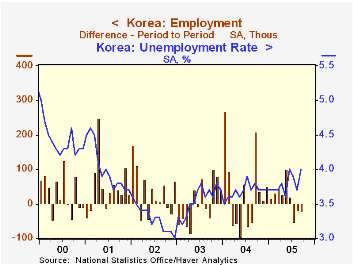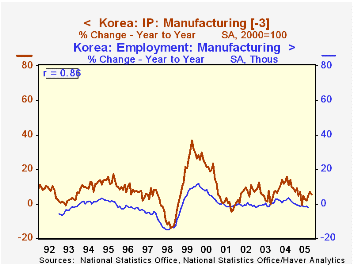 Global| Oct 13 2005
Global| Oct 13 2005September Jobless Rate Rises in Korea; Manufacturing's Share of Employment Diminishes
Summary
Employment in South Korea fell for a third consecutive month in September, based on data seasonally adjusted by Haver Analytics. The cumulative decrease is 92,000, or 1.6% at an annual rate. This is a moderate decline, but Korean [...]

Employment in South Korea fell for a third consecutive month in September, based on data seasonally adjusted by Haver Analytics. The cumulative decrease is 92,000, or 1.6% at an annual rate. This is a moderate decline, but Korean financial markets found it worrisome in conjunction with an increase in the unemployment rate. This latter rose to 4.0% from 3.7% in August and tied with June's level for the highest since June 2001.
Part of the recent softness in jobs is tied to a long-running reduction in the agricultural sector. National accounts data show a flattening of real value added in agriculture over nearly the past eight years, so that gains in productivity are diminishing demand for farm workers, a pattern typical of developing economies. At the same time -- and not typical of developing economies -- manufacturing employment is also somewhat soft. That sector has seen a drop in workers of 2.2% over the last year, including 46,000 in September alone. This continues a decline in the portion of employment in the manufacturing sector, which reached a record low in September of 18.4%, down from 19.0% a year ago.
Month-to-month volatility can explain away some of the recent decrease in factory jobs. But a tempering of output growth since the currency crisis in the late 1990s would also carry some responsibility. Output, shown in the second graph, had just begun to recover when the tech bubble recession cut it back again. A few other facts are apparent in the graph. One, production growth leads employment growth by about a quarter; using Haver's correlation feature in DLXVG3, we see that the highest correlation, 86%, is achieved comparing year-to-year growth rates displaced by three months. Further, employment swings are less dramatic than production swings, and third, production has picked up once again in the most recent months. Thus, one might infer that factory employment could bottom out in the next few months, if not turn upward once again. All this said, we are mildly surprised by the sluggishness in manufacturing in Korea; its big neighbor China must have something to do with that.
| South Korea (000s) | Sept 2005* | Aug 2005* | Jul 2005* | Sept 2004* | 2004 | 2003 | 2002 |
|---|---|---|---|---|---|---|---|
| Employment | 22,836 | 22,857 | 22,877 | 22,592 | 22,557 | 22,139 | 22,169 |
| Mo/Mo Change | -21 | -20 | -51 | 1.0% | 1.9% | -0.1% | 2.8% |
| Manufacturing | 4,204 | 4,250 | 4,230 | 4,297 | 4,290 | 4,205 | 4,241 |
| Mo/Mo Change | -46 | 20 | -8 | -2.2% | 2.0% | -0.9% | -0.6% |
| Manufacturing as % of Total | 18.4% | 18.6% | 18.5% | 19.0% | 19.0% | 19.0% | 19.1% |
| Unemployment Rate | 4.0% | 3.7% | 3.9% | 3.8% | 3.7% | 3.6% | 3.3% |
Carol Stone, CBE
AuthorMore in Author Profile »Carol Stone, CBE came to Haver Analytics in 2003 following more than 35 years as a financial market economist at major Wall Street financial institutions, most especially Merrill Lynch and Nomura Securities. She had broad experience in analysis and forecasting of flow-of-funds accounts, the federal budget and Federal Reserve operations. At Nomura Securities, among other duties, she developed various indicator forecasting tools and edited a daily global publication produced in London and New York for readers in Tokyo. At Haver Analytics, Carol was a member of the Research Department, aiding database managers with research and documentation efforts, as well as posting commentary on select economic reports. In addition, she conducted Ways-of-the-World, a blog on economic issues for an Episcopal-Church-affiliated website, The Geranium Farm. During her career, Carol served as an officer of the Money Marketeers and the Downtown Economists Club. She had a PhD from NYU's Stern School of Business. She lived in Brooklyn, New York, and had a weekend home on Long Island.





